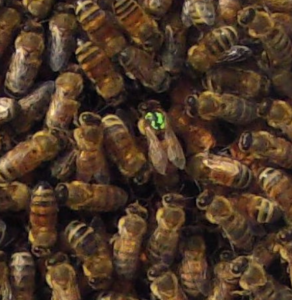
I use this page to tell others about my/ our experience with our honey bees.
Postings are in reverse chronological order, starting with our first colony in May 2019.
(Scroll down to see older postings, all images created by me)
Update 28 January 2024
Things are happening in the bee world. It was time to look into the boxes and see what’s up. The weather today was optimal for an inspection with the outside temp reaching nearly 70 degrees. Since we only have three boxes, the inspection was simple and quick. We discovered that the girls are thriving. We only took a quick peek at a couple of the ten panels in each of the two lower boxes. We could see several of the panels in each box were full of healthy looking brood (new baby bees), and the remaining panels were partially filled with honey.
The top box was heavy, and thus, nearly full of honey. With a large flow of new honey expected in the next two months, we removed two of the ten panels and replaced them with empty panels so they would have a place to draw out new comb and give them a place for the harvester bees to store more of the honey they will undoubtedly produce this coming springtime.
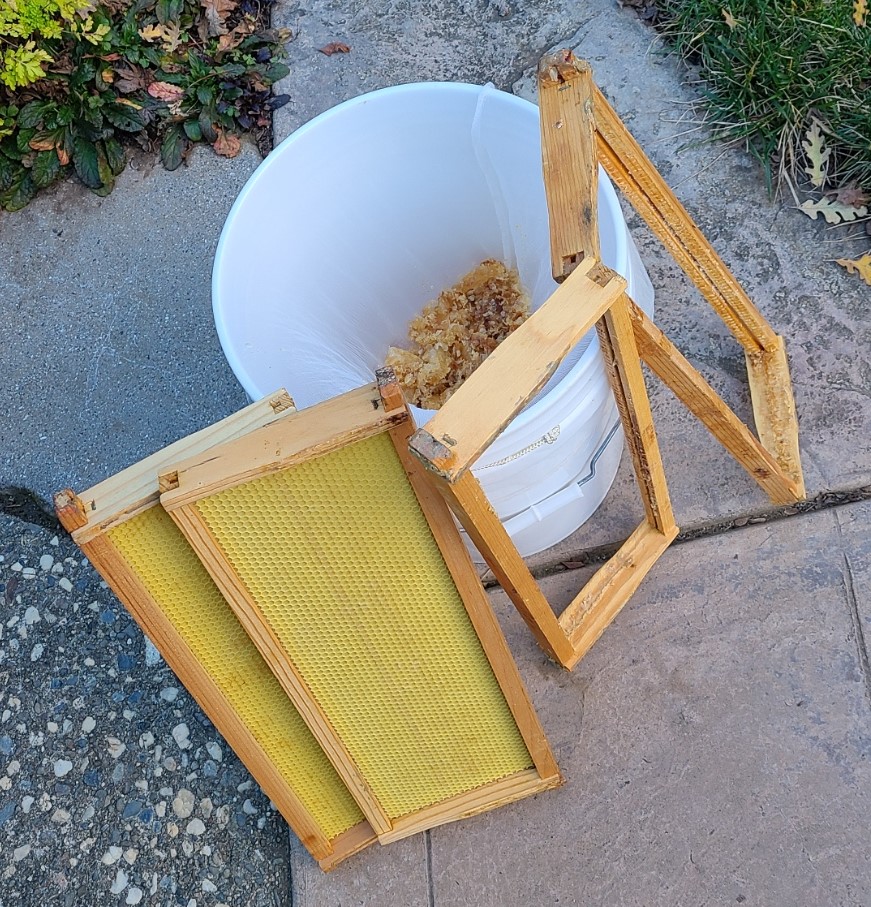
Shown here on the right are the frames of the two panels I removed from the hive. I harvested the wax and honey and discarded the yellow panels. Also shown are two panels, similar to the two I inserted today, that I had reconditioned from last year. I prefer to give the new panels if the old ones are stained.
All said, the honey we harvested was less than about 40 ounces of honey.
I’ll be cleaning up those two empty frames, scraping off the excess wax, and I’ll then install new yellow plastic panels into those empty frames – as I did last season with those show here.
Obviously we don’t keep bees for the harvest of honey. Although we will do this “harvesting” another three or four times between now and the summer, we are simply replacing the panels to allow the bees a place to live and work. As long as we stay ahead of them, they’ll be happy bees and continue to pollinate and they’ll continue to thrive.
19 January 2024
Hard to believe, but this month marks our fifth year anniversary of “bee keeping”… a misnomer for sure, since the bees are more like cats – we don’t “keep them” nor do we control them. We simply provide them with a place to do their thing – feeding them extra food, and occasionally help them with pest control measures. As long as the queen is active, it’s a thriving community of 10,000 to 40,000 creatures that all know their job and they all do it well.
Last year (2023) was another success.
We’re now past the middle of winter – the days are getting longer, and the hive is thriving. On warm days (over 60 deg) they’re out and about, but today, as I write this, the ambient temp is a about 52ish and it’s intermittent light rain, so they’re all staying in their house. We have settled on this configuration of three boxes, with one large hive box at the base with two smaller boxes above that. This is a screen capture from my phone, which has the Kasa app and a simple Kasa camera set up, thus allowing me to look at the boxes through the window at any time….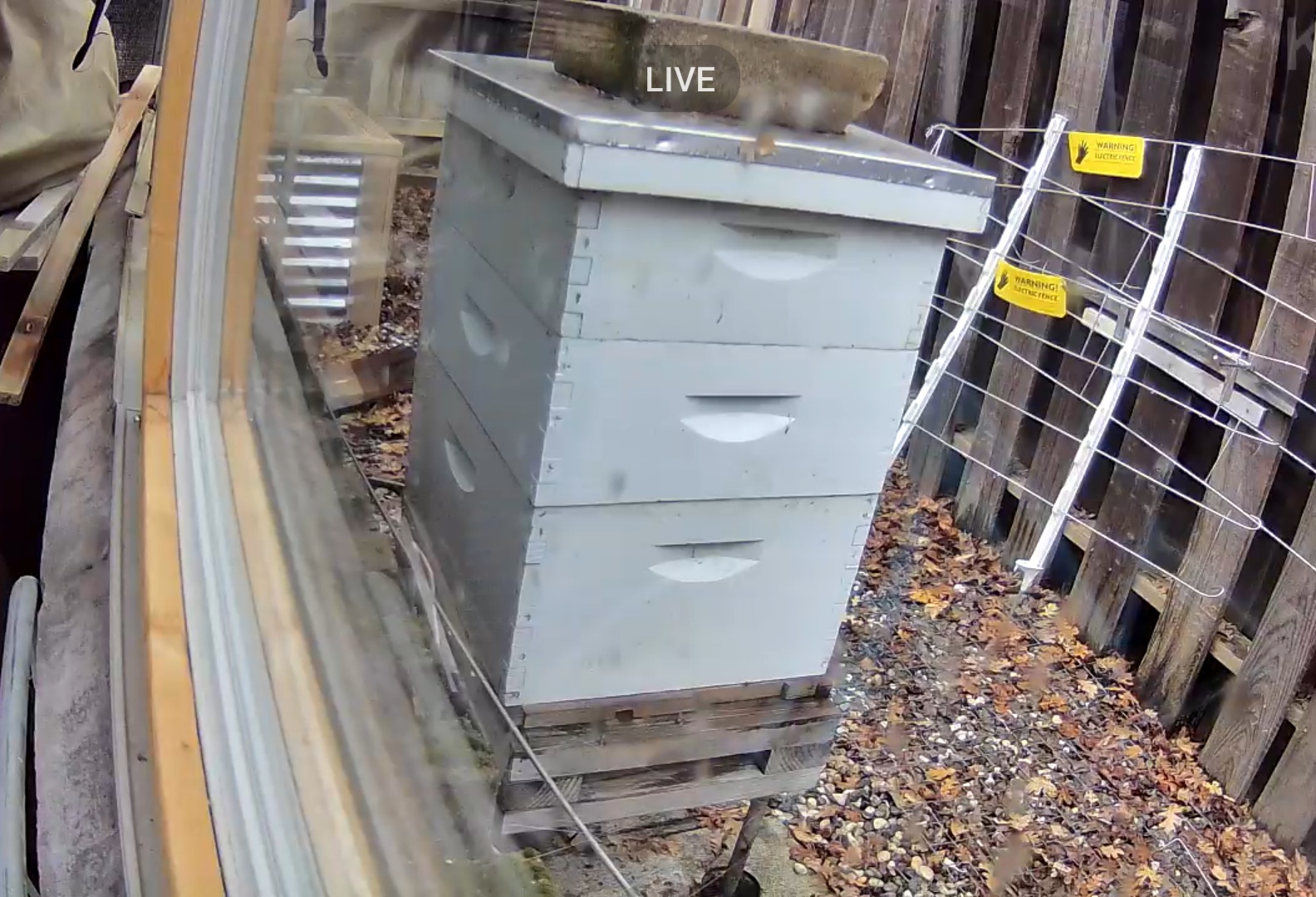
We treated for varooa mites a couple of times in late summer of ’23 and in the fall as well, and we did in fact control those dangerous insects. Granted, there are still a few mites on the bottom board each week when we check, but we are unable to eradicate all of them – only control them so that they don’t kill off the new bees. As long as the girls remain healthy they are able to manage.
Going into the winter this year (Sept thru Nov), they were consuming lots of sugar water and pollen patties. A few days ago on a warm day (over 65 deg) they were out and about in mass. I’d estimate there were 30 or so at a time coming and going in and out, but it was a short session, because after an hour or so the activity subsided to just a few girls going in and out.
As for harvesting of honey in 2023, we only yielded a few frames, which gave us a couple of pints at best. We had a swarm in mid-spring last year, and we just allowed them to “re-queen” themselves… which they did. I’m hoping we deal with the spring swarm season a bit more methodically in 2024 …. I’ll keep you posted!
Update 3/1/23 – March 2023
Our hive is strong and healthy, as far as we can tell. The girls did well over this past winter. However, we can’t the same for most of last year – 2022. We lost our queen in January 2022 and went through lots of trouble to get the hive back up and running. We never lost the entire colony, but we had lots of troubles.
This past 30 days, we’ve treated for varoa mites twice, and added a honey super, so we now have four boxes of bees. It’s too cold to do too much, but we hope to do some more careful inspections in the coming month. The almond orchards are all in bloom, but fruit trees have a few weeks more to go.
Update 5/15/21 –
This is the Late Springtime 2021 update.
We inspected the hive today. All is good. Didn’t spot the Queen, but saw that she is hard at work. Lots of new bees, lots of brood, they ate all of the large pollen patty we gave them and we gave them a fresh one today. Pollen is the protein they feed the babies. No evidence of varroa mites or hive beetles.
We snapped these pix of two of the frames in the large brood box (the bottom box, 9 5/8 inches high).
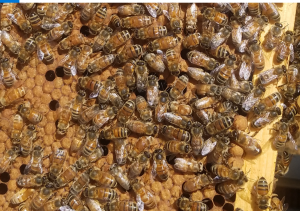

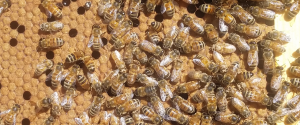
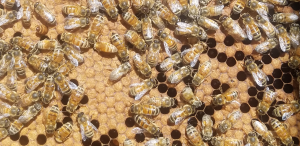
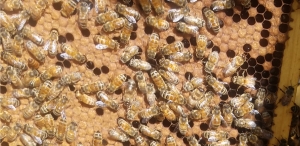
April 2021
This is the Springtime 2021 update.
We’re not sure what happened during January and February of this year, but our best guess is that the girls had weathered the mild winter OK here in northern California (FYI – there are no male bees in the hive during the winter months – they all get kicked out in the early fall). However, it appeared they did have a problem.
We inspected the hive the first week in January (2021), and although we only saw a few brood cells (babies), that seemed like a normal situation. We did not see the queen, but we chose not to disturb them further by searching the entire hive – after all, it was still January.
In early February we took another peek, but again, did not see the queen, and thus we began to worry. There were patchy areas of brood cells – also not a good sign. Then finally, in late March the mystery was solved. Apparently the colony had decided there was a need for a new Queen. The Queen that had been there in the Fall of 2020 was apparently deemed inadequate and was apparently eliminated. We discovered two Supercedure cells *1 (see note *1 below) on March 28 – one was slightly bigger than the other.
Looking at the bigger of the two supercedure cells, it appeared that she was still in her cell – with plenty of attendants nearby. The other cell was a bit smaller than this one, and looked less well looked after.
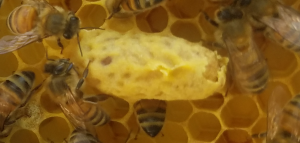
We elected to add another box to the hive, just to be sure they had plenty of room to live and work. Nectar was flowing and there might soon be new bees. They would need the extra room… places to store their honey and lay the new eggs – we were hopeful, thus we added an empty fourth box (full of empty frames) to the top of the three that had made up the hive over the winter months.
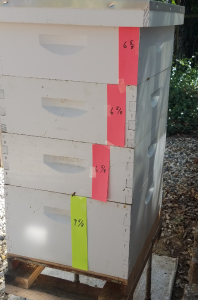 As you can see the lower box (the brood chamber) is a large one (9 5/8 inches) Each of the boxes above that are the small ones of 6 5/8 inches (each box contains ten frames – see note*1).
As you can see the lower box (the brood chamber) is a large one (9 5/8 inches) Each of the boxes above that are the small ones of 6 5/8 inches (each box contains ten frames – see note*1).
At this point, all we could do was hope they would continue their work. The question was – will there be enough nurse bees to feed and to help the new queen survive! Not much we could do except wait and see. She would need to emerge from her cell, spend a few days being nursed and fed and getting stronger, go on mating flights a couple of times, etc.
About four and a half weeks later, on April 20th we did our next inspection of the hive…and…..low and behold, there she was…. in all her splendor…
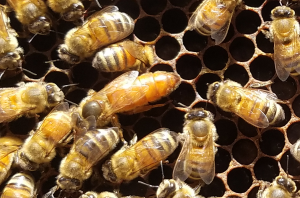
…..but was she fertilized? Did she already complete her mating flights? We could not see any new eggs or pupae*2. She was certainly a big one.. very pretty and healthy looking!
After another nine days our faith and patience was rewarded during our next hive inspection, which was on 4/29/ 2021.
Frame after frame was filled with brood. She certainly had been busy those past nine days! Approximately 20 % of the large frames in the large brood box had large clusters of eggs, and the smaller box just above that first box had two or three faces of the frames with lots of new larvae as well (that’s over 10,000 eggs that she laid in just nine days – an amazing feat!, but that’s what they do). The third box up had no brood, but it did have two or three frames full of honey, and the top box was well populated with bees – building new cells of wax comb, but very little honey at this point. We didn’t remove any honey from any of the boxes. They’ll be needing it to feed all of those babies. I suspect there will be plenty of honey in a few months.
After a successful first year, including a mild rainy winter season, we had not learned enough to prevent our first swarm (in 2020). Here is our second swarm on our second year (we gave this one away to another bee keeper).
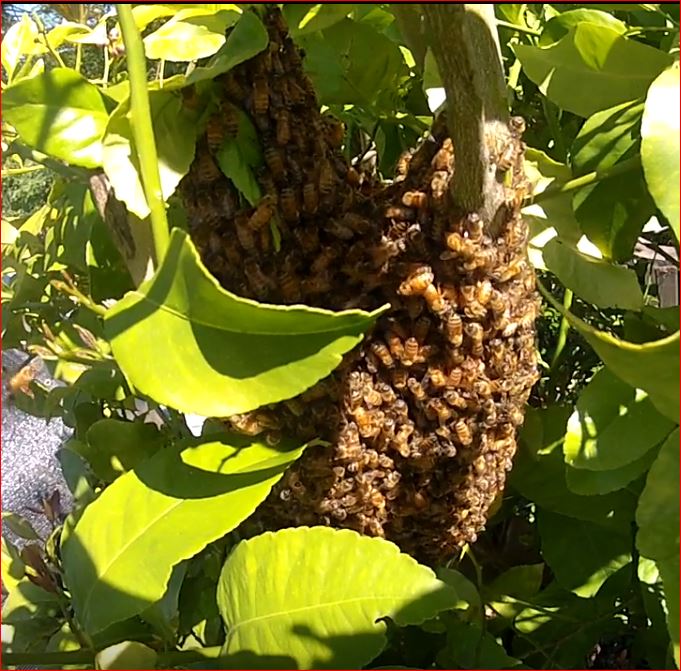

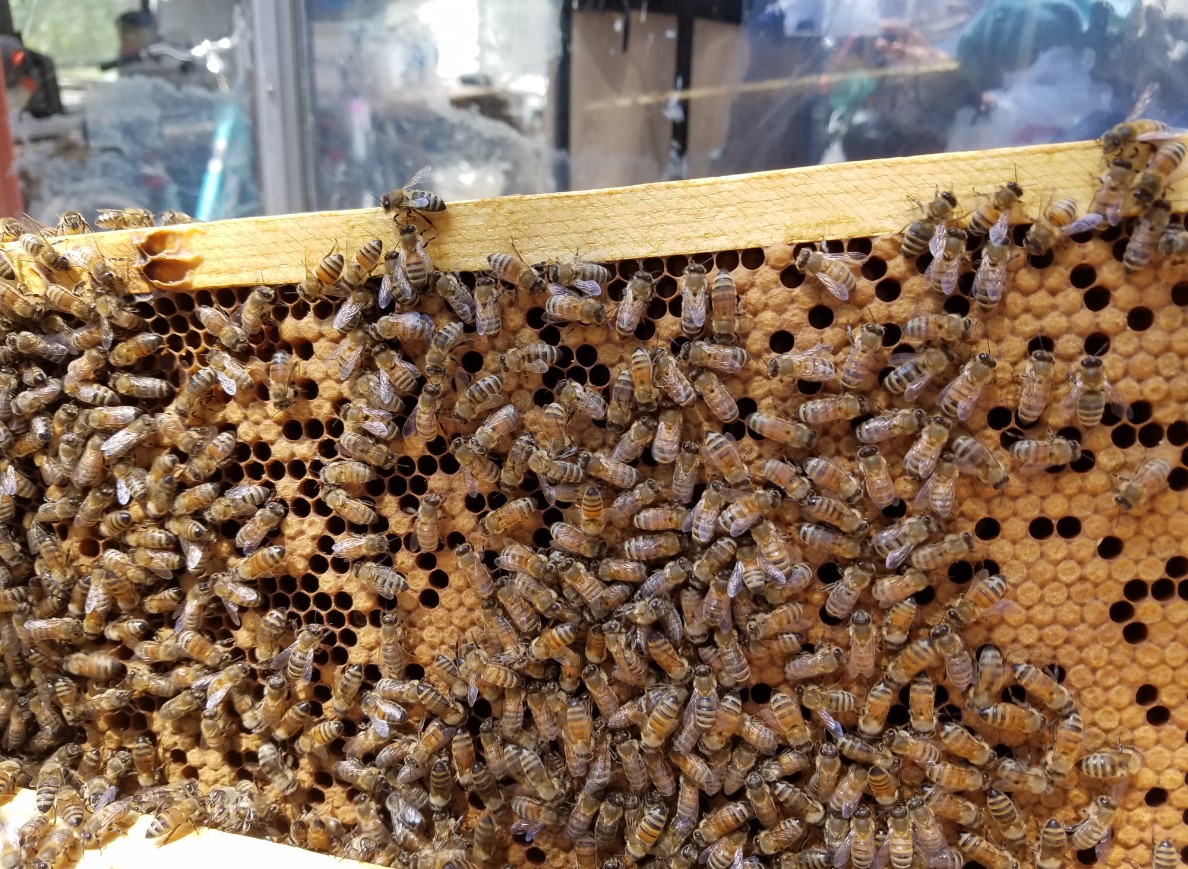
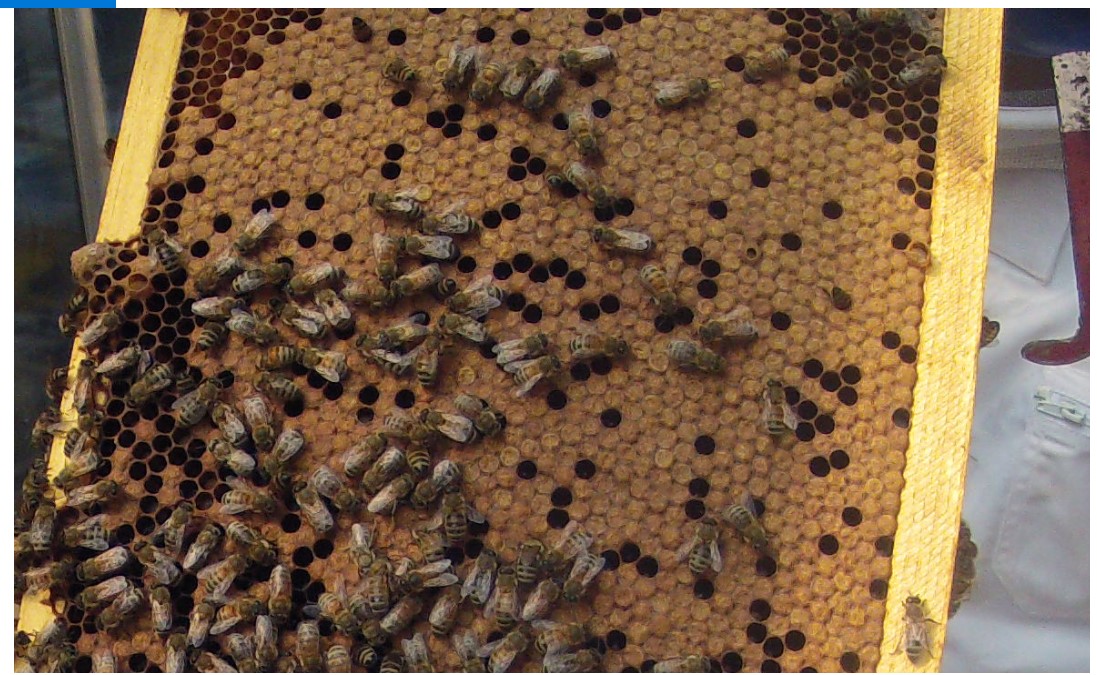
May 2019
In March of 2019 we attended two full day courses at UC Davis, (info about the courses is on line here) purchased (and read) several books, and have watched innumerable videos on the subject of beekeeping. Fortunately for us, we have a warehouse store (Mann Lake Ltd) nearby and have been able to buy all of the right tools and equipment locally. Also available nearby is a “Bee Farm” (Olivarez Honey Bees, Inc), thus we were able to attend a workshop there as well as purchase our first package of bees.
We installed our bees on 4/06/2019 and we are proud to report the colony is flourishing. Queen was released into the colony on 4/09 and we expected to see the babies – the workers – begin to emerge a bit after 5/02, and they did!